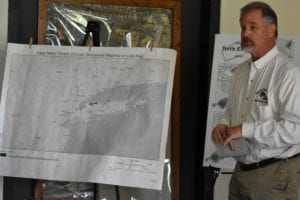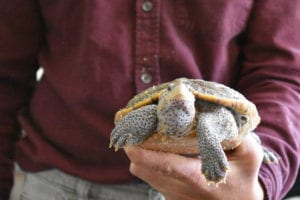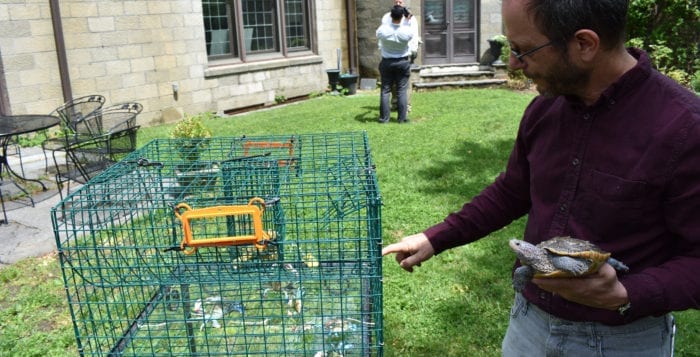It has been a slow crawl saving Long Island’s turtles, but local conservation groups are hoping new state regulations will speed up the process.
The New York State Department of Environmental Conservation and Long Island environmental groups gathered May 23 at the Suffolk County Environmental Center in Islip to celebrate new rules requiring crab cages — used in Long Island’s coastal waters including many of the bays, harbors and rivers that enter Long Island Sound — to have “terrapin excluder devices” (TEDs) on all entrances. As carnivores, terrapins are attracted to bait fish used in commercial, or what’s known as Maryland style crab traps or “pots.” As a result, male and female turtles of all sizes push their way through the entrance funnels and end up drowning.

“With each and every season these traps are not required to have TEDs, there are likely hundreds of terrapins that are drowning,” said John Turner, conservation policy advocate for Seatuck Environmental Association, which operates the Islip center. “To me, one of the signs of a real civilized society is how we treat other life-forms. We haven’t treated terrapins very well.”
He said in Stony Brook Harbor alone there are dozens, maybe hundreds of terrapins that will spend the winter in the mud, emerging once the water runs up high enough. Turner said many of the North Shore areas that are home to these turtles, like Setauket Harbor, Conscience Bay, Port Jefferson Harbor, Mount Sinai Harbor and Nissequogue River, play a key role in preserving the species.
“In contrast to where I am in South Jersey, I can go by the canals and I can see a dozen [terrapin] heads bobbing up and down,” said James Gilmore, director of the marine resources division at the state DEC. “Here, it’s very rare to see one. Hopefully these new rules will help us see more.”
Gilmore said the DEC began working on changing state regulations in 2013 but have known long before there was a problem.
Carl LoBue, The Nature Conservancy’s New York ocean program director, said it was in the late 1990s he’d witnessed recreational crab traps in Stony Brook Harbor. One day he lifted a cage out of the water while trying to move his landlord’s boat and saw it was filled with trapped terrapins. Two were still alive, but five
had already drowned.
“With each and every season these traps are not required to have TEDs, there are likely hundreds of terrapins that are drowning.”
— John Turner
“I’m sure the crabber wasn’t intent to kill turtles,” LoBue said. “But when I looked across the bay at the 60 or something crab traps this person had set, I was crushed thinking of the terrapins drowning at that very moment.”
In the early 2000s terrapins became a popular meal in New York, but the harvest of those turtles led to a massive decrease in population, especially the diamondback terrapin, which was identified as a species of greatest conservation need in the 2015 New York State Wildlife Action Plan. In September 2017 the DEC passed regulations banning the commercial harvest of diamondbacks.
Terrapin population has slowly increased since then, but researchers say there’s still little known about the population, like life expectancy or habits while in water. The species has a very slow birth rate, with low local clutches of 10 or so eggs — sometimes only one or two of which hatch and mature.
Russell Burke, a professor of biology at Hofstra University, said terrapins could live very long lives, pointing to older specimens he has seen living to 60 years old, but he estimated some could be twice that age. While Burke said it’s hard to estimate the total population on Long Island, he said in Jamaica Bay alone, he knows there are approximately 3,500 adult females.

The TED devices are 4 3/4 inches by 1 3/4 inches, an exact measurement, to ensure that while crabs can get through, turtles cannot. According to Kim McKown, leader of the Marine Invertebrate and Protected Resources Unit at the state DEC, the small, plastic TEDs cost $10 for the three needed to secure a normal crab trap. The cost exponentially increases depending on how many traps a fisherman has, with some owning up to 1,000 traps.
Turner said his organization used its own funds and purchased 5,000 TEDs and gifted them to the DEC. The state agency is giving them to Long Island crab fishermen on a first come, first served basis.
Commercial crab fisherman Fred Chiofolo, who hunts in Brookhaven Town along the South Shore, experimented with TEDs on his own for years before the regulations were passed. He said the devices
even improved the number of crabs caught.
“It made a significant difference with the pots that had them versus the pots that didn’t,” Chiofolo said. “Last year I put them in every pot I had — about 200 of them. I’m not going to lie it’s a lot of work to put them in, but we don’t want to catch the turtle. I don’t want them, and [the TED] does keep them out.”





